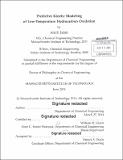| dc.contributor.advisor | William H. Green. | en_US |
| dc.contributor.author | Jalan, Amrit | en_US |
| dc.contributor.other | Massachusetts Institute of Technology. Department of Chemical Engineering. | en_US |
| dc.date.accessioned | 2014-10-21T17:23:28Z | |
| dc.date.available | 2014-10-21T17:23:28Z | |
| dc.date.copyright | 2014 | en_US |
| dc.date.issued | 2014 | en_US |
| dc.identifier.uri | http://hdl.handle.net/1721.1/91059 | |
| dc.description | Thesis: Ph. D., Massachusetts Institute of Technology, Department of Chemical Engineering, 2014. | en_US |
| dc.description | Cataloged from PDF version of thesis. | en_US |
| dc.description | Includes bibliographical references (pages 221-235). | en_US |
| dc.description.abstract | Low temperature oxidation in the gas and condensed phases has been the subject of experimental investigations for many decades owing to applications in many areas of practical significance like thermal stability, combustion, atmospheric chemistry and industrial syntheses. Owing to several practical limitations it has proven difficult to understand these processes at a mechanistic level from experiments alone. Developments in scientific computing have opened up computational chemistry and cheminformatics based tools as an attractive option for exploring and elucidating the kinetics of these complex processes through detailed kinetic modeling and requires efforts in three key areas: single reaction kinetics, reaction networks and coupling kinetics with mass/momentum/energy balance models. This thesis presents several contributions employing high-level electronic structure calculations, reaction rate theory, automated kinetic modeling and empirical correlations to further our mechanistic understanding of low-temperature oxidation in the gas and liquid phase. First, an extensible framework for automatic estimation of species thermochemistry in the solution phase is presented and validated. This framework uses the Linear Solvation Energy Relationship (LSER) formalism of Abraham/Mintz and co-workers for high-throughput estimation of [delta]G°solv(T) in over 30 solvents using solute descriptors estimated from group additivity. The performance of scaled particle theory (SPT) expressions for enthalpic-entropic decomposition of [delta]G°solv(T) is also discussed along with the associated computational issues. Second, the importance of solvent effects on free-radical kinetics is explored using tetralin oxidation as a case study. The solvent dependence for the main propagation and termination reactions are determined using the Polarizable Continuum (PCM) family of solvation models. Incorporating these kinetic solvent effects in detailed kinetic models suggest oxidation rates increase with solvent polarity, consistent with experiment. Following this, electronic structure methods and reaction rate theory are used elucidate mechanistic details of new pathways in liquid-phase and atmospheric oxidation. The first of these studies focuses on pathways that establish [gamma]-ketohydroperoxides (KHP), well-known products in low-temperature alkane oxidation, as precursors to acids through a two-step process. Ab initio calculations are used to identify pathways leading from KHP to a cyclic peroxide isomer which decomposes through novel concerted reactions into carbonyl and carboxylic acid products. High-level gas phase rate coefficients are obtained using DFT/WFT methods coupled with VTST/SCT calculations and multi-structural partition functions (QMs-T). Solvent effects are included using continuum dielectric solvation models and the predicted rate coefficients found to be in excellent agreement with experiment lending theoretical support to the 30-year old Korcek hypothesis. Next, insights from the Korcek reaction are extended to atmospheric chemistry where similar cyclic peroxides are formed by reactions of the Criegee Intermediate (*CH₂OO*) with double bonds. More specifically, the role of chemical activation in reactions between *CH₂OO* and C=O/C=C species is explored using master equation calculations to obtain phenomenological rate coefficients k(T,P). In the case of reactions with C=O, the yield of collisionally stabilized SOZ at atmospheric pressure was found to increase in the order HCHO < CH₃CHO < CH₃COCH₃ - At low pressures, chemically activated formation of organic acids was found to be the major product channel in agreement with recent direct measurements. Epoxide and CH₂=CHOH are predicted to be the major products for *CH₂OO* + C₂H₄ under atmospheric conditions. Finally, as a case study in coupling detailed chemical and physical models, the improved understanding of liquid phase oxidation developed above is used to build multi-physics models of diesel injector deposit formation that adversely affects fuel spray characteristics and engine efficiency. Octane is used as a model liquid fuel for detailed kinetic modeling of oxidative aging leading to deposit precursors. In addition to fuel chemistry, the immiscibility of polar oxidation products leading to 'soft deposit' is modeled using linear solvation energy relationships. The chemistry and phase separation models are coupled with physical processes like washing. The resulting framework is used to explore the sensitivity of deposit formation to various model parameters. | en_US |
| dc.description.statementofresponsibility | by Amrit Jalan. | en_US |
| dc.format.extent | 235 pages | en_US |
| dc.language.iso | eng | en_US |
| dc.publisher | Massachusetts Institute of Technology | en_US |
| dc.rights | M.I.T. theses are protected by copyright. They may be viewed from this source for any purpose, but reproduction or distribution in any format is prohibited without written permission. See provided URL for inquiries about permission. | en_US |
| dc.rights.uri | http://dspace.mit.edu/handle/1721.1/7582 | en_US |
| dc.subject | Chemical Engineering. | en_US |
| dc.title | Predictive kinetic modeling of low-temperature hydrocarbon oxidation | en_US |
| dc.type | Thesis | en_US |
| dc.description.degree | Ph. D. | en_US |
| dc.contributor.department | Massachusetts Institute of Technology. Department of Chemical Engineering | |
| dc.identifier.oclc | 892072036 | en_US |
